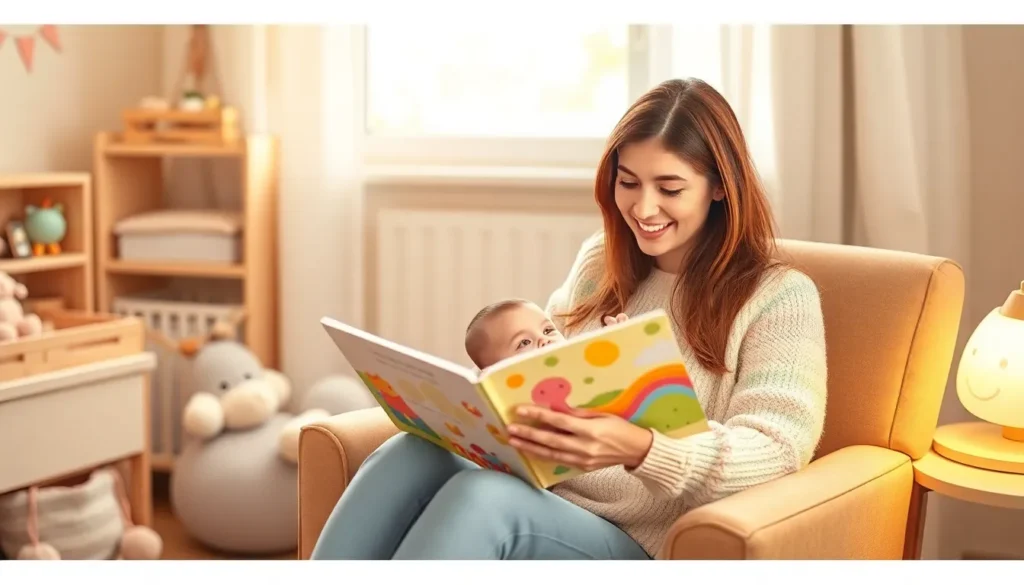Table of Contents
ToggleNavigating parenthood can feel like trying to assemble a crib without the instructions—confusing and slightly terrifying. That’s where baby books come in, acting as the trusty manual every new parent desperately needs. From sleep-deprived nights to diaper disasters, these books offer guidance, humor, and a sprinkle of sanity in the chaos of raising a tiny human.
Imagine flipping through pages filled with expert tips and relatable stories that make you chuckle while you’re knee-deep in baby wipes. These books aren’t just for the little ones; they’re a lifeline for parents needing reassurance and a good laugh. Whether it’s learning to decipher baby cries or mastering the art of the perfect swaddle, the right baby book can transform a bewildered parent into a confident caregiver. So dive in and discover the perfect reads that’ll have you saying, “I’ve got this!” while secretly Googling how to get baby food out of the carpet.
Benefits of Reading Baby Books for Parents
Reading baby books offers numerous advantages for parents navigating the early stages of childcare. These resources enhance understanding and foster better parenting practices.
Cognitive Development
Baby books support cognitive development for both parents and infants. Parents gain insights into child psychology and developmental milestones by reading about growth stages. Understanding these concepts allows parents to respond appropriately to their child’s needs. Engaging with these texts also helps parents learn effective communication techniques. They can discover how to stimulate their child’s curiosity through questions and interactive reading. Knowledge absorbed from these books empowers parents to create enriching environments that promote learning and exploration.
Emotional Bonding
Reading together nurtures emotional bonding between parents and babies. Shared reading experiences create moments of intimacy. As parents read aloud, they convey love and affection through their tone and expressions. These interactions foster a secure attachment, which is crucial for healthy emotional development. Furthermore, books often feature themes that resonate with both parents and children, facilitating discussions about feelings and experiences. By regular reading, parents help their children build emotional vocabulary and resilience, strengthening their relationship as they explore stories together.
Types of Baby Books for Parents

Various types of baby books cater to the needs of parents, each serving a unique purpose in the parenting journey.
Picture Books
Picture books capture a child’s attention through vivid imagery. They introduce storytelling in a playful manner, laying the foundation for language development. Parents use these books to engage infants, fostering interaction and curiosity for the world around them. Each page with beautiful illustrations sparks imagination, often accompanied by simple text. Many popular titles, such as “Brown Bear, Brown Bear, What Do You See?”, encourage repetition and predictability, making them favorites among parents and children alike. Reading picture books regularly supports vocabulary growth and builds a love for reading early in a child’s life.
Board Books
Board books offer durability and a tactile experience for young hands. Designed for infants and toddlers, these books withstand rough handling while remaining highly engaging. Often featuring bright colors and sturdy pages, they introduce essential concepts like numbers, letters, and basic shapes. Titles like “Goodnight Moon” provide rhythmic and soothing text, perfect for bedtime routines. Parents appreciate the easy-to-clean surfaces, essential for little ones exploring the world through touch. These books not only enhance familiarity with language but also strengthen the bond between parent and child during shared reading time.
How to Choose the Right Baby Books
Selecting appropriate baby books involves considering various factors. Parents should focus on their child’s age and developmental stage.
Age Appropriateness
Books designed for specific age groups help maximize engagement. Infants benefit from board books featuring simple text and bright images. At three to six months, babies become more responsive to colors and contrasting patterns. By six to twelve months, they enjoy interactive elements such as textures and lift-the-flap designs. Toddlers, aged one to three, prefer stories with repetitive phrases and relatable scenarios. Ensuring age-appropriate selections enhances interest and comprehension.
Themes and Topics
Considering themes plays a crucial role in choosing suitable baby books. Topics such as family dynamics, daily routines, and friendships resonate well with young readers. Books that address emotions like happiness, sadness, or fear support social and emotional development. Exposure to diverse themes builds a broad understanding of the world. Parents can foster curiosity and acceptance by selecting books that introduce different cultures, environments, and experiences. Engaging themes will encourage meaningful discussions and enhance parental bonding.
Tips for Reading to Your Baby
Reading to a baby creates a nurturing experience that promotes development and bonding. Parents can enhance this time by following some effective strategies.
Creating a Reading Routine
Establish a consistent reading routine that fits into daily activities. Setting aside time each day for reading helps babies anticipate and enjoy these moments. Morning or bedtime offers ideal opportunities to incorporate books into the schedule. Selecting a cozy spot creates a comfortable environment, encouraging engagement. Alternating between different types of books keeps the experience fresh and stimulating. Repeating favorite stories fosters familiarity and excitement. Observing the baby’s responses can guide parents in selecting themes or topics that capture their interest.
Engaging with the Story
Engagement starts with using expressive voices and gestures to bring stories to life. Making eye contact while reading strengthens the connection between parent and baby. Additionally, pointing out colorful illustrations invites interaction. Asking questions, even if the baby can’t respond, nurtures communication skills. Allowing pauses during the reading provides space for reactions and encourages babies to express themselves. Incorporating tactile elements, such as lift-the-flap features, enhances the sensory experience. Sharing enthusiasm for the story cultivates a love for reading, making it an enjoyable part of the day.
Exploring baby books can be a transformative experience for new parents. These resources not only provide crucial guidance but also foster a deeper connection between parent and child. By choosing age-appropriate books and engaging in shared reading, parents can enhance their child’s development while building a nurturing environment.
The journey of parenthood may be filled with challenges, but baby books offer a reassuring companion. They empower parents to navigate the complexities of raising a child with confidence and joy. Embracing these literary tools can lead to enriching experiences that benefit both parents and their little ones for years to come.







